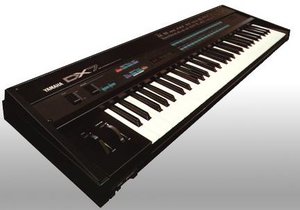Yamaha DX7
|
|
The Yamaha DX7 was a synthesizer manufactured by the Yamaha Corporation from 1983 to 1986, based on FM synthesis. It was the first commercially successful digital synthesizer, with its sound included in many recordings from the 1980s.
One major reason for the success was the precision and flexibility of digital sounds. Although the DX7 was a not a sampler, its bright sounds were much clearer than the analog synthesizers that preceded it. Although the DX7 claimed to use FM, it actually incorporated phase modulation synthesis, an 'upgrade' on the FM technique. The DX7 is well-known for its electric piano, bells, and other "metal striking metal" sounds. It was monotimbral and capable of 16-note polyphony.
The tone generation algorithms used were highly programmable, but it is said that 90% of all DX7 owners simply used the 32 factory default patches, and never tried to program their own patches. The synthesizer included MIDI ports, but was released shortly before the specification was completed, and has incomplete support for the standard.
Several improved models were released in later years, most notably the DX7IID which improved sound quality and allowed bi-timbrality. Third-party products for the DX7 also flourished in the 80s, including Grey Matter Response's E! expansion board, which added sequencer functions to the keyboard. The DX7 family remains popular to this day with many recording and performing artists. A software synthesizer from Native Instruments called the FM7 is also now available which emulates the DX7's digital circuitry and can use original DX7 patches.
External links
- DX7 page on Vintage Synth Museum (http://www.vintagesynth.com/yamaha/dx7.shtml) A photograph, samples of DX7 sounds and a few technical details.
- DX7 page at Hollow Sun (http://www.hollowsun.com/vintage/fm/index.html) A collection of famous DX7 samples.de:DX7

